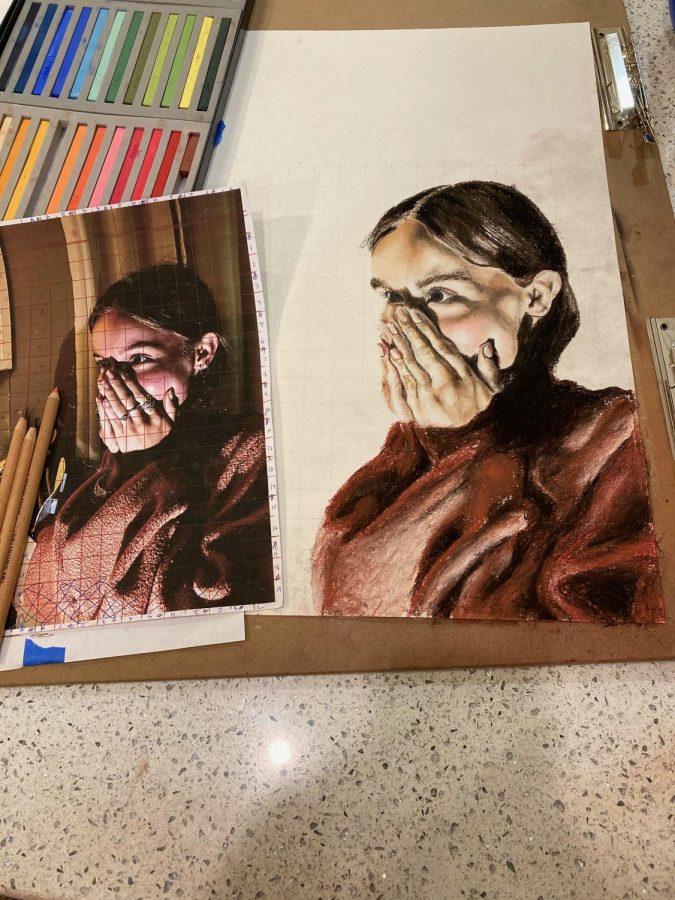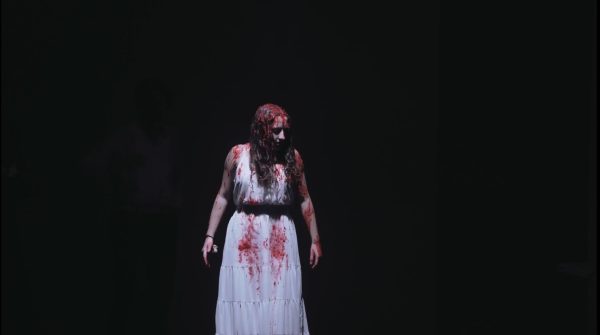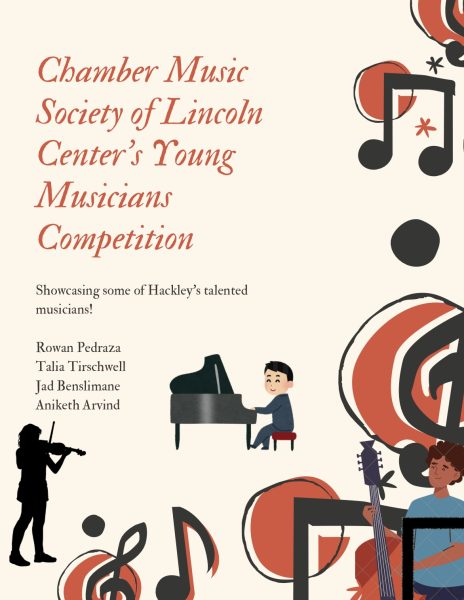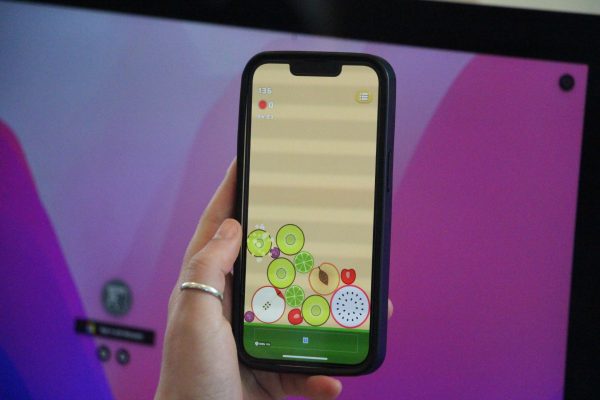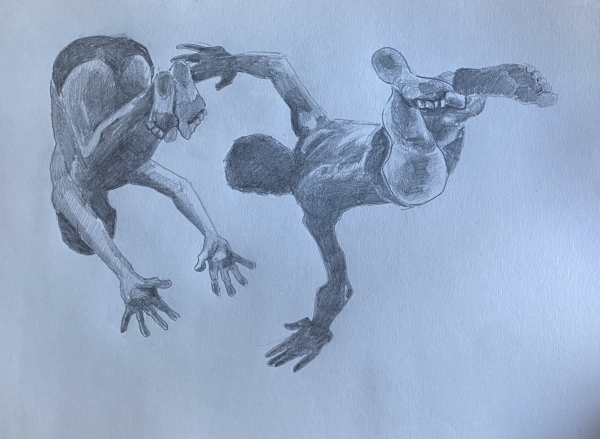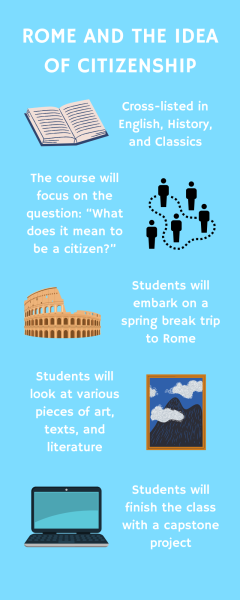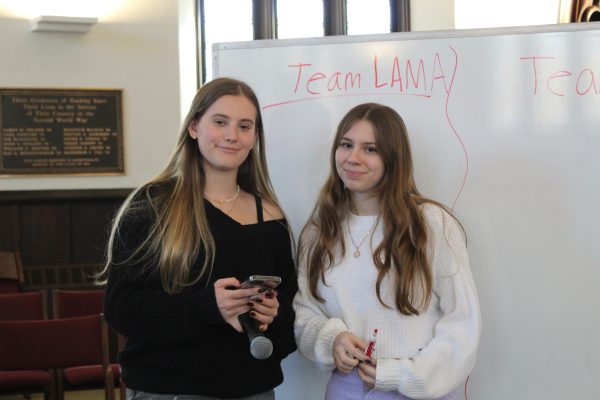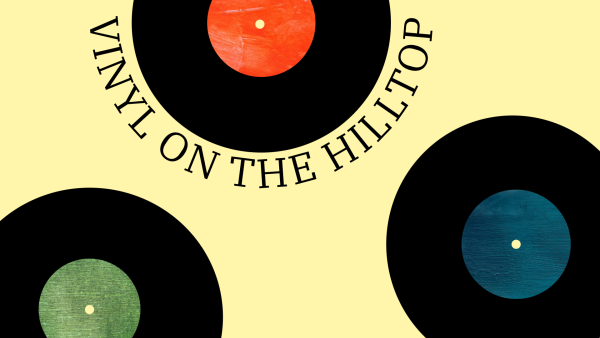AP Art Students Complete Their Portfolios
The AP Studio Art class this year has five students instructed by Greg Cice and he discusses the nature of the course; one student, in particular, Sophie Miller, also discusses the artwork she has completed. Throughout the years of Hackley’s course offerings, AP Studio Art has been taught by Greg Cice and taken by a plethora of students. Both discuss the general layout of the course and the interesting works students have completed to meet the AP’s requirements.
Greg Cice has been teaching AP Studio Art at Hackley for 20 years. This is one of his several teaching roles as Hackley’s Department Chair of Visual Arts. Over the years, there have been class sizes as large as 16 and the average has been roughly ten students.
The curriculum is largely structured by the AP and every student has to meet its requirements by uploading a portfolio in May.
“During the course of the year, students spend pretty much all of their time inside and outside of class fulfilling those portfolio requirements,” said Mr. Cice.
Due to the course being regarded as too rigorous for students the College Board modified the portfolio requirements within the past two years. However, Mr. Cice did like the AP’s previous requirements as well as several students. Now the new AP curriculum requires students to submit a portfolio on sustained investigation work. This work focuses on “a concept, theme, idea, direction, exploration” of their own choosing, Mr. Cice explained. The sustained investigation portfolio incorporates 15 pieces of art.
In addition to the sustained investigation portfolio, the AP Studio Art course also requires a selected works portfolio where students choose their strongest pieces from the sustained investigation portfolio. Over the years, students have chosen different themes on which to base their sustained investigation portfolio.
Self-portraiture is a popular topic even though the human figure is the most difficult to draw. The human figure is a complex subject because one has to be very precise with the drawing. “Not surprisingly figural subjects are very popular in the Hackley studio because Hackley students like to do things that are really hard,” Mr. Cice said.
Some students have focused on the surface of water and the refractory qualities as well as what happens to objects when they are viewed through water. One previous student was fascinated by the underwater world and did a series of drawings regarding his brother and himself swimming. Another student centered her exploration around gummy bears where she completed a complex narrative and series of images that told a story of the gummy bears going to war.
Senior Max Calman is doing a series of portrait drawings that are created out of chaos. He is trying “to organize chaos in a portrait by creating a very readable and accurate image out of just scribbles,” Mr. Cice said. His final piece is roughly 12 feet long made solely out of scribbles.
Senior Annabelle Gray is doing a series of drawings and self-portraits reflected in broken mirrors. So rather than the water refracting the image she is refracting an image through the reflection. In order to create her images, Annabelle and Mr. Cice first had to find a mirror and break it very carefully in order to produce the best images. They also had to secure the broken mirror on a surface enabling Annabelle to use the mirror repeatedly for images.
Senior Mira Zaslow is fascinated by the medical world so she is creating a series of images that explores “what is for most of us the uncomfortable world of dissection in surgery,” Mr. Cice stated. So she has her images of organs being manipulated.
Senior Meredith Greenberg is doing a series of portraits that explores the experience of sleep. Instead of depicting the portrait as we are normally accustomed to seeing it, awake and engaging with the viewer, she is approaching her subject matter in its unconscious state or right at the moment of awakening. She also injects her own frightful narrative since she introduces elements that threaten the sleeping subject. She is trying to raise the idea that when we are asleep we are in a vulnerable state.
One AP Art student, in particular, senior Sophie Miller, has her sustained investigation work revolve around nonverbal communication. She would draw people with intense facial expressions and hand gestures. She chose this because she wanted to “draw with elevated contrast, so this seemed like a cool outlet for that.” She always loved to draw and began with Foundations of Studio Art in freshman year then proceeded to the intermediate major in sophomore year. Her intermediate class only had five people but they all stuck together and continued their journey, reaching AP Art in senior year.
When asked about the level of difficulty in this course, she responds, “depends on your definition of difficult. It’s definitely time-consuming.” She spends about half of her overall drawing time at home and during frees. She also stays up a few nights a month to meet deadlines, but she loves the class. She adds, “my classmates are hilarious, and I’ve always found drawing to be really calming, so overall I don’t mind the time commitment.” Since AP Art is another major, Sophie took six majors sophomore and junior year but five majors and two minors her senior year. The curriculum requires 15 sustained investigation pieces so she finishes a piece around every two to three weeks.
Sophie adds that at each deadline they hang new pieces on a wall and talk through them one by one helping push their sustained investigation work forward. In an earlier critique this year, she was told to try black and white in one of her pieces and now has ten of her fifteen in that way.
Sometimes students are unsure of what they want to spend their time working on for their concentration. In this case, Mr. Cice helps guide them by asking questions. He raises questions regarding what students want to draw, what they are interested in, as well as any other interests they have in general. His goal is to allow them to find inspiration and lots of times students’ portfolios come from an AP artist taking one or two things they are interested in and creating a coalition. Last year Ocean Saric did not know what he wanted to do for his concentration but he was interested in space. He decided to start with astrological subject matter and was also fascinated by human skeletons. So he wanted to bring both of those ideas together and ended up creating a portfolio with cosmic scenes and skeletons floating through them.
Although the AP deadline may linger over students with it in their minds, they try not to focus on the finished portfolio in May. Instead, they try to put their energy and effort into the journey.
“The portfolio, in my mind, is more of a journey than it is an object,” Mr. Cice said, “The AP studio class is really about how rich of a journey can each student have towards their vision.”
Students have a rough idea regarding their vision at the beginning of the year and they try to deepen that exploration throughout the remaining time in the year. Sometimes “we go down blind alleys and we have to turn around and come back but that’s all part of the process,” Mr. Cice reflects. But he states, “The richer the journey that they have towards completing the portfolio requirements, the better the experience and typically the finer work in the end.”

